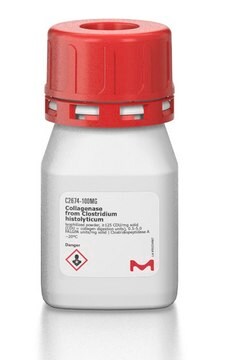推荐产品
等級
pharmaceutical primary standard
製造商/商標名
USP
應用
pharmaceutical
形式
neat
儲存溫度
−70°C
正在寻找类似产品? 访问 产品对比指南
一般說明
胶原蛋白酶II是一种金属蛋白酶,起内肽酶作用,并表现出三肽羧肽酶活性。显示内肽酶活性时,主要裂解位点位于人类胶原蛋白双链氨基酸甘氨酸-脯氨酸之前。水解发生在胶原蛋白三螺旋区域的内部。胶原蛋白酶II也被称为II类胶原蛋白酶,包含三种亚型:δ、ε和ζ。 胶原蛋白酶II USP参考标准按现行药典规定交付。所有为支持本产品而提供的信息,包括MSDS和任何产品信息单均由药典颁发机构制定并发布。如需进一步信息和支持,请访问现行药典网站。
生化/生理作用
每摩尔胶原蛋白酶被4g原子钙活化。 它被乙二醇-双(β-氨基乙基醚)-N,NN′,N′-四乙酸,β-巯基乙醇、谷胱甘肽、巯基乙酸和8-羟基喹啉抑制。
單位定義
一个胶原蛋白消化单元(CDU)从牛跟腱胶原蛋白中释放的肽链量和1.0 μ亮氨酸,5小时,pH7.4,37℃,在钙离子存在下的茚三酮颜色相同。一个 FALGPA水解单元每分钟,25℃,水解1.0 μmole 呋喃基丙烯酰-Leu-Gly-Pro-Ala。一个中性蛋白酶单元水解酪蛋白,产生颜色和1.0 μmole 酪氨酸每5小时,pH7.5,37℃下产生的相同。一个梭菌蛋白酶单元在DTT存在下,pH7.6,25℃,每分钟水解1.0 μmole BAEE。
分析報告
这些产品仅供测试和化验使用。它们不适用于人类或动物,也不能用于诊断、治疗或治愈任何类型的疾病。
其他說明
该产品是美国药典生物制品计划的一部分。
訊號詞
Danger
危險聲明
危險分類
Resp. Sens. 1
儲存類別代碼
12 - Non Combustible Liquids
水污染物質分類(WGK)
WGK 1
閃點(°F)
Not applicable
閃點(°C)
Not applicable
其他客户在看
Yasin Emre Kaya et al.
Turkish neurosurgery, 30(3), 434-441 (2020-04-03)
To investigate the effects of metformin, a drug used widely for the treatment of type 2 diabetes mellitus, on human primary cell cultures prepared from uninjured segment of disc material intervertebral disk tissues. Primary cell cultures were prepared using the
Michalis Mastri et al.
American journal of clinical and experimental urology, 9(6), 416-434 (2022-01-08)
The evolving paradigm of the molecular classification of bladder cancer requires models that represent the classifications with less heterogeneity. Robust transcriptome based molecular classifications are essential to address tumor heterogeneity. Patient derived models (PDMs) are a powerful preclinical tool to
我们的科学家团队拥有各种研究领域经验,包括生命科学、材料科学、化学合成、色谱、分析及许多其他领域.
联系技术服务部门








